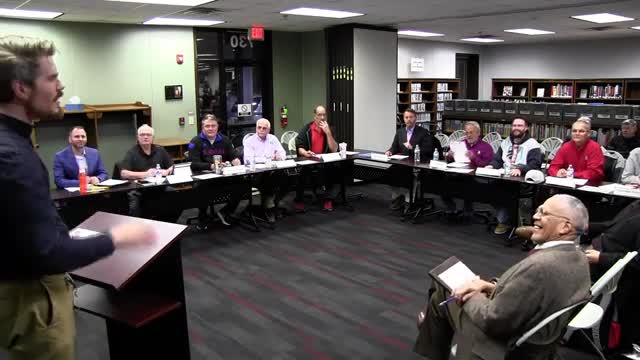New Frontier Museum Promises Interactive Experience for All Ages
November 22, 2024 | Lansing City, Leavenworth County, Kansas
This article was created by AI summarizing key points discussed. AI makes mistakes, so for full details and context, please refer to the video of the full meeting. Please report any errors so we can fix them. Report an error »

During a recent government meeting, officials presented an ambitious plan for the new Frontier Museum of the United States Army, aimed at enhancing public engagement with military history. Brian, along with George Pettigrew and Bridal Woffler, outlined the vision for the museum, which will be located between the Grant and Sherman Gates at Fort Leavenworth.
The museum's design incorporates significant cultural elements, including a logo featuring nine stars representing the frontier states and feathers symbolizing Native American heritage. The facility will cover 90,000 square feet, with 28,000 square feet dedicated to exhibit space, making it one of the largest military history museums in the country. Notably, it will include a rotating exhibit space, a first for an Army museum, allowing for diverse displays from various collections, including those from the Smithsonian.
To attract families and younger visitors, the museum will feature interactive experience centers for both children and adults. These areas will include hands-on activities, such as clothing try-ons and 3D printing, designed to make military history accessible and engaging. The layout will also prioritize accessibility, with gentle slopes and cross-paths to facilitate movement throughout the museum.
The outdoor space will host a powwow site, intended for cultural events and community gatherings, alongside native plant landscaping to promote environmental sustainability. The museum aims to serve as a regional event center, drawing visitors to both the museum and the surrounding historical sites.
Officials emphasized the importance of storytelling in the museum's narrative, focusing on the experiences of individuals who shaped the American frontier, including women and children, rather than solely on military history. The museum is expected to become a vital educational resource, fostering a deeper understanding of the American experience.
The project is currently in the planning stages, with ongoing discussions about funding and support from local and national representatives. The team is optimistic about the museum's potential to become a significant cultural landmark, enhancing the community's connection to its historical roots.
The museum's design incorporates significant cultural elements, including a logo featuring nine stars representing the frontier states and feathers symbolizing Native American heritage. The facility will cover 90,000 square feet, with 28,000 square feet dedicated to exhibit space, making it one of the largest military history museums in the country. Notably, it will include a rotating exhibit space, a first for an Army museum, allowing for diverse displays from various collections, including those from the Smithsonian.
To attract families and younger visitors, the museum will feature interactive experience centers for both children and adults. These areas will include hands-on activities, such as clothing try-ons and 3D printing, designed to make military history accessible and engaging. The layout will also prioritize accessibility, with gentle slopes and cross-paths to facilitate movement throughout the museum.
The outdoor space will host a powwow site, intended for cultural events and community gatherings, alongside native plant landscaping to promote environmental sustainability. The museum aims to serve as a regional event center, drawing visitors to both the museum and the surrounding historical sites.
Officials emphasized the importance of storytelling in the museum's narrative, focusing on the experiences of individuals who shaped the American frontier, including women and children, rather than solely on military history. The museum is expected to become a vital educational resource, fostering a deeper understanding of the American experience.
The project is currently in the planning stages, with ongoing discussions about funding and support from local and national representatives. The team is optimistic about the museum's potential to become a significant cultural landmark, enhancing the community's connection to its historical roots.
View full meeting
This article is based on a recent meeting—watch the full video and explore the complete transcript for deeper insights into the discussion.
View full meeting
